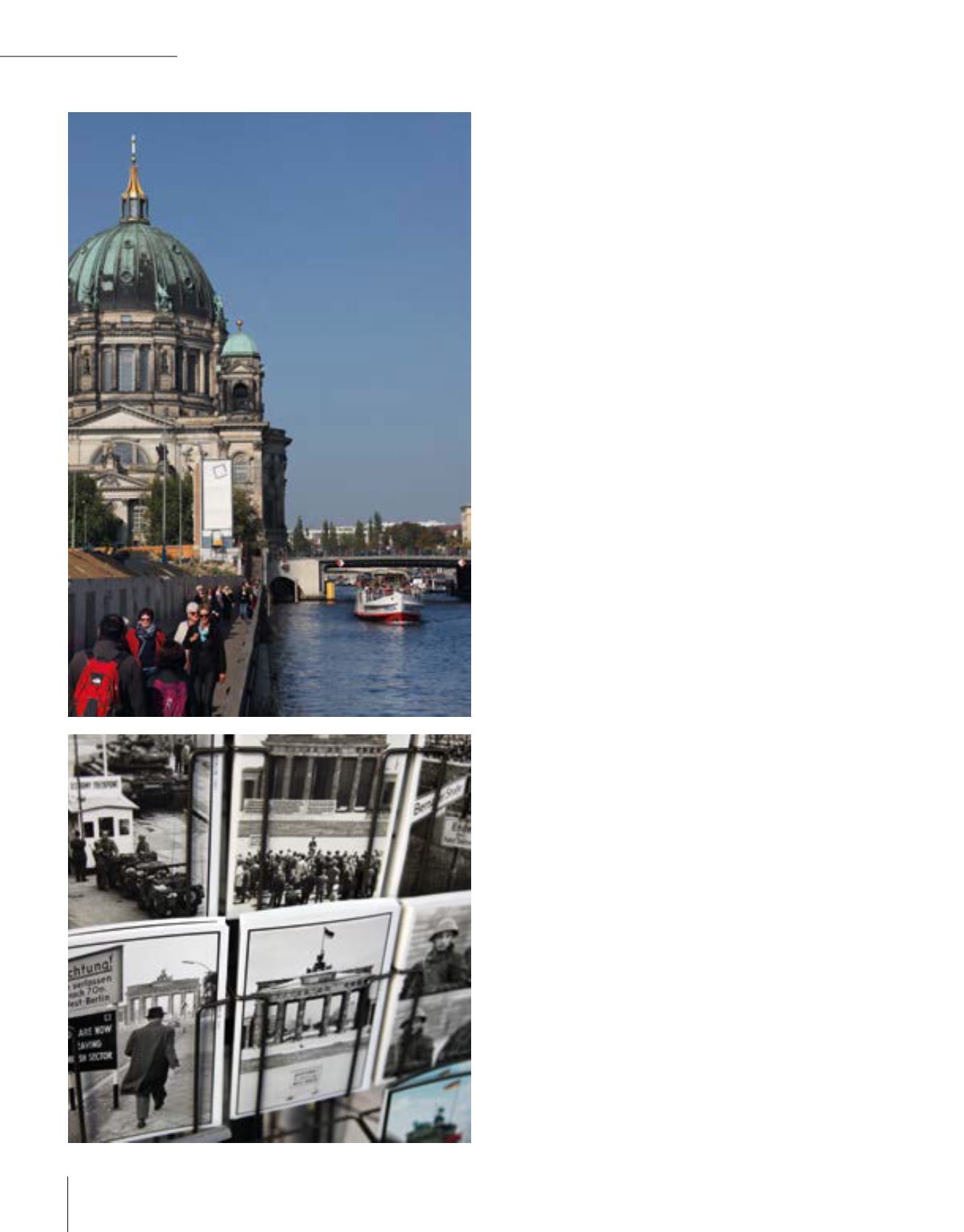
110
uzaktaki yakın
so far so close
ve sonrası. Öncesinde
Alman İmparatorluğu’na da
başkentlik yapan Berlin, 1933
yılından sonra Nazi Almanyası
ve Hitler’in de başkentiydi.
Hitler demişken; bir küçük
not olarak Berlin seyahatiniz
boyunca birçok müze ve
tarihi alan gezecek olmanıza
rağmen malum şahsın ismini
pek nadir duyacak, cismini
ve de resmini neredeyse
hiç görmeyeceksiniz.
Genelinde Avrupa ve insan
ırkı, özelinde Alman toplumu
için bir utanç kaynağı olan bu
diktatör adeta hafızalardan
kazınmaya çalışılıyor anladığım
kadarıyla....
Neredeyse diğer tüm Avrupa
kentleri gibi Berlin de 2.
Dünya Savaşı’nda harabeye
dönmüş. Sovyet Kızıl Ordusu
tarafından ele geçirilen
kent 1945’te kapitülasyona
uğramış. Yani savaşın galibi
4 büyük müttefik devlet
arasında tıpkı Almanya gibi
başkent Berlin’in de 4 sektöre
bölünmesi kararlaştırılmış.
Daha sonra yolları keskin bir
şekilde ayrılacak olan müttefik
devletlerden batılı olanlar
(ABD, Fransa ve Birleşik
Krallık) şehrin batısını işgal
ederken Sovyetler de kentin
doğusunda söz sahibi olmuş.
Haritaya bakarsanız Batı
Berlin’in Doğu Almanya
toprakları içinde kaldığını
göreceksiniz. Bir süre
sonra Sovyetler Batı
Berlin’e ekonomik ambargo
uygulamaya başlamış. Bundan
yılmayan Batılı Müttefikler
bir uç karakola da dönüşen
Batı Berlin’e havadan
destek vermeyi sürdürmüş.
Batıda Almanya Federal
Cumhuriyeti’nin kurulması
üzerine 1949’da -bugün
nedenini bilmiyorum ama
hafızalarımızda efsane bayan
milli gülle atma takımlarıyla
yer etmiş olan- Demokratik
Almanya Cumhuriyeti (DDR)
nam-ı diğer Doğu Almanya
Like almost all other European
cities, Berlin was in ruins after
the WW2. Invaded by the Soviet
Red Army in 1945, it was divided
into 4 sectors, like the rest of
Germany, among the winners of
the war, the 4 allied states, who
later on parted ways dramatically.
While the western ones (the USA,
France, and the UK) invaded the
west of the city, the Soviets had a
say in the eastern part.
If you look at the map you will see
that West Berlin is on the East
German land. Later on, Soviets
put an economic embargo on
West Berlin. The Western Allies,
not losing heart, continued
aerial support of Berlin which
turned into a border post. After
the foundation of the Federal
Republic of Germany (FRG) in
the west, in 1949 the German
Democratic Republic (GDR-in
other words East Germany) was
established and for some reason
it is embedded in our minds
with its legendary ladies shot
put team. However, since West
Berlin belonged to FRG, it was
granted some special rights. The
crossing between east and west
of Berlin were only made from
certain spots and only for some
authorities. The most famous one
of those, which is today a hub
for tourists, was the Checkpoint
Charlie at the American part
of the city. Civilians were not
allowed to cross to West Berlin
and snipers were placed on the
borders. Still, after the division,
until 1955, using the Berlin
subway 270 thousand civilians
crossed over to West Germany,
that had great economic growth
with the help of its Western
Allies. Hence, the Soviet Union,
regarding West Berlin as a
menace, a castle of capitalism,
a source of anti-propaganda,
came up with the solution of
building an actual wall. On
August 12th, 1961, the temporary
construction of the Berlin Wall
was started and completed
overnight. Other than the
people jumping from the roofs
and windows of the buildings
adjacent the wall, the people
who dug tunnels, the ones who
tried to demolish the wall with
their cars or the ones who left
their border patrolling jobs and
ran to the other side, the people
who are today subjects of history
books and museums, Berliners


